Top 10 Fruits Highest in Magnesium
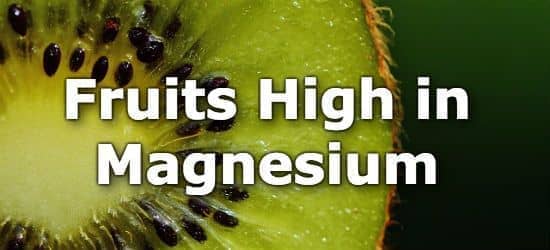
Magnesium is an essential mineral required by the body for muscle and nerve function, maintaining heart rhythm, building strong bones, and energy production. (1,2,3)
Magnesium is an electrolyte, and a deficiency in magnesium can lead to numbness, abnormal heart rhythms, coronary spasms. (4) In the long term, magnesium deficiency increases the risk of stroke, Alzheimer's disease, Parkinson's disease, and migraine. (5)
Fruits are high in fiber and are also a very good source of potassium in addition to magnesium.
Fruits high in magnesium include dried figs, avocados, guavas, bananas, kiwi fruit, papayas, blackberries, raspberries, cantaloupes, and grapefruit. The daily value (DV) for magnesium 420mg per day. (6,7)
Below are the top 10 fruits highest in magnesium. For more, see the extended list of less common fruits rich in magnesium, high magnesium vegetables, and the article on high magnesium foods.
List of Fruits High in Magnesium
-
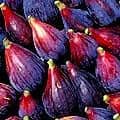 1. Dried Figs + Add
1. Dried Figs + Add
Magnesium
1 CupMagnesium
per 100gMagnesium
per 200 Calories101mg
(24% DV)68mg
(16% DV)55mg
(13% DV)More Dried Fruit High in Magnesium
- 21% DV per cup of prunes
- 19% DV per cup of apricots
- 16% DV per cup of dates
- 15% DV per cup of zante currants
- 14% DV per cup of raisins
-
2. Avocados + Add
Magnesium
per AvocadoMagnesium
per 100gMagnesium
per 200 Calories58mg
(14% DV)29mg
(7% DV)36mg
(9% DV) -
 3. Bananas + Add
3. Bananas + Add
Magnesium
per Cup SlicedMagnesium
per 100gMagnesium
per 200 Calories41mg
(10% DV)27mg
(6% DV)61mg
(14% DV) -
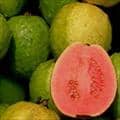 4. Guavas + Add
4. Guavas + Add
Magnesium
per CupMagnesium
per 100gMagnesium
per 200 Calories36mg
(9% DV)22mg
(5% DV)65mg
(15% DV) -
 5. Kiwifruit + Add
5. Kiwifruit + Add
Magnesium
per CupMagnesium
per 100gMagnesium
per 200 Calories31mg
(7% DV)17mg
(4% DV)56mg
(13% DV) -
6. Papaya + Add
Magnesium
per CupMagnesium
per 100gMagnesium
per 200 Calories30mg
(7% DV)21mg
(5% DV)98mg
(23% DV) -
 7. Blackberries + Add
7. Blackberries + Add
Magnesium
per CupMagnesium
per 100gMagnesium
per 200 Calories29mg
(7% DV)20mg
(5% DV)93mg
(22% DV) -
 8. Raspberries + Add
8. Raspberries + Add
Magnesium
per CupMagnesium
per 100gMagnesium
per 200 Calories27mg
(6% DV)22mg
(5% DV)85mg
(20% DV) -
9. Cantaloupe + Add
Magnesium
per CupMagnesium
per 100gMagnesium
per 200 Calories21mg
(5% DV)12mg
(3% DV)71mg
(17% DV) -
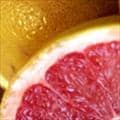 10. Grapefruit + Add
10. Grapefruit + Add
Magnesium
1 Cup SectionsMagnesium
per 100gMagnesium
per 200 Calories21mg
(5% DV)9mg
(2% DV)43mg
(10% DV)
Printable One Page Sheet
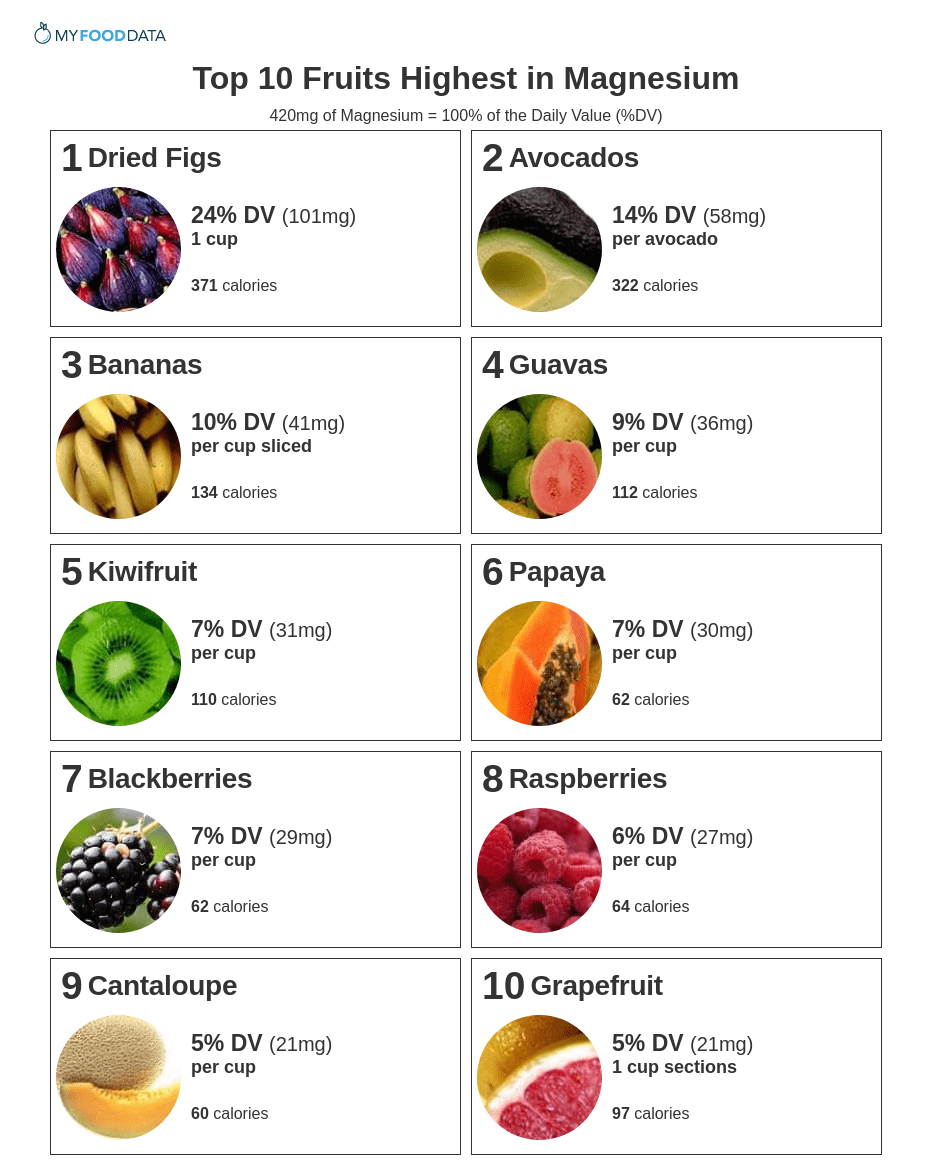
Even More Magnesium Rich Fruits
| Food | Serving | Magnesium |
|---|---|---|
| 1. Prickly Pears + | per cup | 30% DV (127mg) |
| 2. Plantains + | 1 cup mashed | 20% DV (82mg) |
| 3. Passion-Fruit (Granadilla) + | per cup | 16% DV (68mg) |
| 4. Breadfruit + | 1 cup | 13% DV (55mg) |
| 5. Jackfruit + | 1 cup sliced | 11% DV (48mg) |
| 6. Sapodilla + | 1 cup pulp | 7% DV (29mg) |
| 7. Mulberries + | per cup | 6% DV (25mg) |
| 8. Strawberries + | per Cup | 5% DV (22mg) |
| 9. Watermelon + | per cup | 4% DV (15mg) |
| 10. Rhubarb + | per cup | 3% DV (15mg) |
How Much Magnesium Do You Need Everyday?
The daily value (%DV) for Magnesium is 420mg and is a general target intended for most people. The Recommended Daily Allowance (RDA) shows specific targets by age and gender. The RDA for magnesium is between 300mg - 420mg for most people. (7)
| Life Stage | RDA |
|---|---|
| Children | |
| 1-3 years old | 80mg |
| 4-8 years old | 130mg |
| Males | |
| 9-13 years old | 240mg |
| 14-18 years old | 410mg |
| 19-30 years old | 310mg |
| 31-70 years old | 420mg |
| 70+ years old | 420mg |
| Females | |
| 9-13 years old | 240mg |
| 14-18 years old | 360mg |
| 19-30 years old | 310mg |
| 31-70 years old | 320mg |
| 70+ years old | 320mg |
| Pregnancy | |
| 14-18 years old | 335mg |
| 19-30 years old | 290mg |
| 31-50 years old | 300mg |
| Lactation | |
| 14-18 years old | 400mg |
| 19-30 years old | 350mg |
| 31-50 years old | 360mg |
From the Nutrient Ranking Tool
Use the ranking tool links below to select foods and create your own food list to share or print.
- Foods High in Magnesium
- Foods Low in Magnesium
- Vegetables High in Magnesium
- Fruits High in Magnesium
- Vegetarian Foods High in Magnesium
- Nuts High in Magnesium
- Grains High in Magnesium
- Beans High in Magnesium
- Dairy High in Magnesium
- Breakfast Cereals High in Magnesium
- Fast Foods High in Magnesium
View more nutrients with the nutrient ranking tool, or see ratios with the nutrient ratio tool.
Related
Data Sources and References
- Limaye CS, Londhey VA, Nadkart MY, Borges NE. Magnesium and Human Health: Perspectives and Research Directions J Assoc Physicians India. 2011 Jan;59:19-22. 21751660
- Robertson SP, Johnson JD, Potter JD. Magnesium and the regulation of muscle contraction Biophys J. 1981 Jun;34(3):559-69. doi: 10.1016/S0006-3495(81)84868-0. 7195747
- Robertson SP, Johnson JD, Potter JD. Magnesium and the regulation of muscle contraction Biophys J. 1981 Jun;34(3):559-69. doi: 10.1016/S0006-3495(81)84868-0. 7195747
- Rude RK. Clinical manifestations of magnesium deficiency Endocrinol Metab Clin North Am. 1993 Jun;22(2):377-95. 8325293
- Kirkland AE, Sarlo GL, Holton KF. The Effect of Magnesium Deficiency on Neurological Disorders: A Narrative Review Article Nutrients. 2018 Jun 6;10(6):730. doi: 10.3390/nu10060730. 29882776
- U.S.FDA - Daily Value on the New Nutrition and Supplement Facts Labels
- Institute of Medicine (US) Food and Nutrition Board. Dietary Reference Intakes for Calcium, Phosphorus, Magnesium, Vitamin D, and Fluoride Washington (DC): National Academies Press (US); 1998. 20845565
Simplify Nutrition Tracking with MyFoodData!
Speedy Tools and Detailed Data FREEEasily analyze your meals to find the best foods for your goals.
✅ Use our recipe nutrition calculator and nutrition comparison tool.
✅ Access expert nutrition data tools and in-depth articles.
✅ Log foods and organize your recipes with a free account.


 Next ➞
Next ➞
